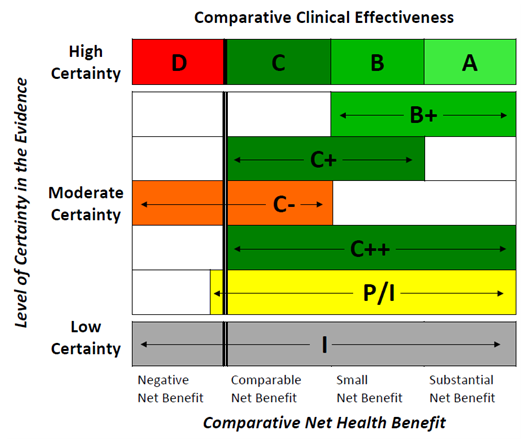Evidence Rating Matrix
The ICER Integrated Evidence Rating™ combines a rating for comparative clinical effectiveness and a rating for comparative value. The clinical effectiveness rating arises from a joint judgment of the level of confidence provided by the body of evidence and the magnitude of the net health benefit — the overall balance between benefits and harms. This method for rating the clinical effectiveness is modeled on the “Evidence- Based Medicine (EBM) matrix” developed by a multi-stakeholder group convened by America’s Health Insurance Plans.

- A = “Superior” – High certainty of a substantial (moderate-large) net health benefit
- B = “Incremental” – High certainty of a small net health benefit
C = “Comparable”- High certainty of a comparable net health benefit - D= “Negative”- High certainty of an inferior net health benefit
- B+= “Incremental or Better” – Moderate certainty of a small or substantial net health benefit, with high certainty of at least a small net health benefit
- C+ = “Comparable or Incremental” – Moderate certainty of a comparable or small net health benefit, with high certainty of at least a comparable net health benefit
- C- = “Comparable or Inferior” – Moderate certainty that the net health benefit is either comparable or inferior, with high certainty of at best a comparable net health benefit
- C++ = “Comparable or Better” – Moderate certainty of a comparable, small, or substantial net health benefit, with high certainty of at least a comparable net health benefit
- P/I = “Promising but Inconclusive” – Moderate certainty of a small or substantial net health benefit, small likelihood of a negative net health benefit
- I = “Insufficient” – Any situation in which the level of certainty in the evidence is low
